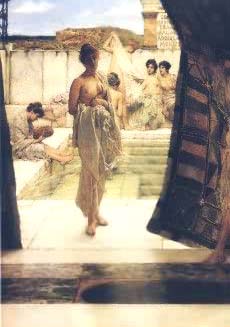





HOME
|

|

|

|

|
|
P R O F I L E |
||||
|
  The Ancient Baths of Classical Rome
The Ancient Baths of Classical Rome Rome Italy 
The Thermal Baths of Classical Rome are without doubt one of the Seven Wonders of the Spa World. Even what remains today is awe inspiring. In 33 BC there were 170 baths in Rome according to Agrippa's census. Baths were a popular public facility for Emperors to provide as was demonstrated by Nero and Trajan, however it was in 212 AD that the building of the Baths of Caracalla was commenced, the most sumptuous and grandiose baths ever built, to be followed in the year 292 AD with the Baths of Diocletian, the largest baths complex ever. The Baths of Caracalla were in use for three centuries before they lost their aqueduct water supply in the siege of Rome 537 AD. The baths could accommodate between 6,000 and 8,000 bathers a day. In spite of centuries of abandonment and plundering, the surviving site is virtually intact. Located to the south of the city of Rome, the ruins today tower some 30 metres above ground across the 11 hectare site, which includes extensive underground levels for service ducts etc. The equivalent of 9,000 workers were employed for a period of 5 years to create this masterpiece, both in size and magnificence. Lavish decoration included floors of marble and mosaics, hundreds of statues and embellishments of walls and ceilings that elevated the baths to the status of the grandest of palaces. They were visited by all social levels and were the meeting place for the populace of both sexes. 
The Baths of Diocletian have not survived so well in many respects. Although now preserved, much of the ruins, which lie nearer the centre of Rome, have been lost due to road schemes and general plundering over the centuries. The site occupied over 13 hectares in its original form. The water came from the Aqua Marcia and travelled some 91 km from the source springs; it remains one of the most important sources for present day Rome. A fortuitous restoration occurred in the 16th century when Michelangelo was commissioned to restore part of the baths as a church. The works took 200 years to complete, conserving many of the original features in the central area to produce The Basilica of Saint Mary of the Angels and the Martyrs, an edifice of huge proportions, albeit only occupying part of the original baths building. This restoration provides a unique opportunity to appreciate the size and elaborate decoration of the original baths. Part of the remaining structure of the baths is now occupied by the State Museum. As the Spas Research Fellowship found out during a recent field trip, both Baths complexes are open to the public and justify a visit to Rome just to appreciate these masterpieces, the scale and elaboration of which have not been replicated since. Email: www.pierreci.it (click here to send an email) Website: Click Here ADDITIONAL INFORMATION For the Baths of Diocletian head for Termini metro and bus station, for the Baths of Caracalla head for Circus Maximus. These are the best two sites to visit to study ancient Terme or Baths in Rome. Both complexes have bookshops where suitable and well written guides can be purchased in a variety of languages. Both sites are important heritage sites and do not contain modern spa facilities. Baths of Caracalla - Via delle Terme di Caracalla 52 - Information and reservations phone 06 39 96 77 00 - On-line booking click on email above. Baths of Diocletian - the historic site of the Museo Nazionale Romano houses the epigraphic and protohistoric department - Viale E. De Nicola SNC - phone 06 39 96 77 00. FACILITIES Conducted Tours of Locality, Free Entry, Restaurant/Food |
||||
|